It’s undeniable that the abundance of palm trees is one of the defining characteristics of California’s streets, complementing the state’s renowned attractions.
Surprisingly, the most ubiquitous palm tree in California is not even native to the Golden State. Here are 25 California palm trees and how to distinguish them.
1. Canary Island Date Palm (Phoenix canariensis)

This is a very popular palm tree in the streets of California with its pineapple-like canopy and graceful shape.
- Where they grow: All over California streets and beaches and UK
- Average size: 40 to 60 feet tall, 40 feet wide
- Growth rate: 2 feet per year
- Distinguishing characteristics: Diamond patterns and thick growth under the crown
2. California Fan Palm (Washingtonia filifera)

This is the only palm tree that’s native to California. The fronds are shaped like a fan and have waxy green blades.
- Where they grow: California and the Western United States
- Average size: 40 to 60 feet tall, 20 feet wide
- Growth rate: 1.5 feet each year
- Distinguishing characteristics: Under the crown, the tree has a petticoat of dead leaves
3. Guadalupe Palm (Brahea edulis)

The fan-shaped fronds have bluish-green and low canopy. It has a stout trunk covered with scars of fallen dead fronds.
- Where they grow: Southern California
- Average size: 30-40 feet tall and 10-15 feet wide
- Growth rate: 12 inches yearly
- Distinguishing characteristics: Fragrant yellow flowers in the summer
4. King Palm (Archontophoenix alexandrae)

This palm tree has graceful growth and adds class to any landscape. Originally from Australia, it’s a landmark in coastal California.
- Where they grow: California and Australia
- Average size: 100 feet tall, 15 feet wide
- Growth rate: 2-4 feet per year
- Distinguishing characteristics: Arching fronds, slim trunk, graceful upright growth
5. Queen Palm (Syagrus romanzoffiana)

This is another popular palm in the streets and beaches of California with a smooth trunk and arched fronds with feather-like leaflets.
- Where they grow: Warm climates in California and other regions
- Average size: 50 to 70 feet tall, 20 to 30 feet wide
- Growth rate: 2 feet per year
- Distinguishing characteristics: The fronds are curved like feathers and smooth
6. Kentia Palm (Howea forsteriana)

A very ornamental palm that is the focal point in many lawns and gardens all over the Golden State.
- Where they grow: California
- Average size: 20 to 60 feet tall, 15 feet wide
- Growth rate: 1.5 feet each year
- Distinguishing characteristics: Arching fronds and leaflets shaped like a V
7. Windmill Palm (Trachycarpus fortunei)

The windmill palm is named for its uniquely shaped fronds which are grouped together to create a decorative canopy.
- Where they grow: California
- Average size: 10-40 feet tall and 10 feet wide
- Growth rate: 1 foot yearly
- Distinguishing characteristics: Fronds arranged in bunched groups
8. Date Palm (Phoenix dactylifera)

Although mostly grown for its abundant yield of delicious and juicy dates, the tree is also quite ornamental.
- Where they grow: Coastal areas of California
- Average size: 50 to 80 feet tall, 20 to 40 feet wide
- Growth rate: 1-2 feet per year
- Distinguishing characteristics: Large clusters of fruits and arching fronds
9. Pygmy Date Palm (Phoenix roebelenii)
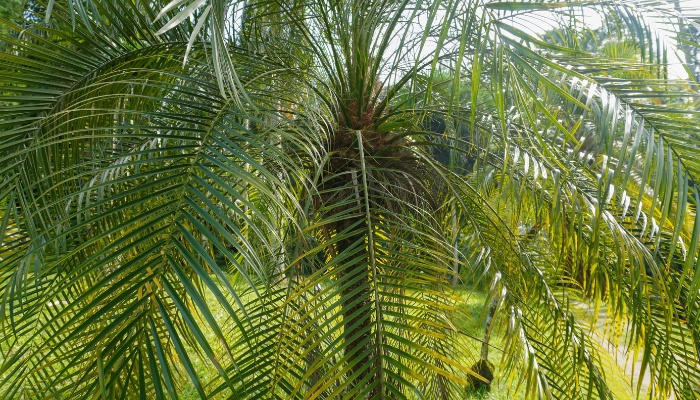
Small and compact, this palm can grow in any small corner in your yard, or you can put it in a container if you wish.
- Where they grow: Native to southeastern Asia, hardy to Zones 10 and 9b
- Average size: 6.5 feet tall and 5 feet wide
- Growth rate: 10 inches yearly
- Distinguishing characteristics: Compact size, thick trunk, and lush green fronds
10. Mexican Fan Palm (Washingtonia robusta)

The unique skirt-like growth at the top of the trunk is the reason for this palm’s popularity. That and its round crown.
- Where they grow: Hardy to Zone 9a
- Average size: 40 to 80 feet tall, 8 to 10 feet wide
- Growth rate: 2 feet each year
- Distinguishing characteristics: Round crown, skirt-like growth under the crown, and slim trunk
11. European Fan (Chamaerops humilis)
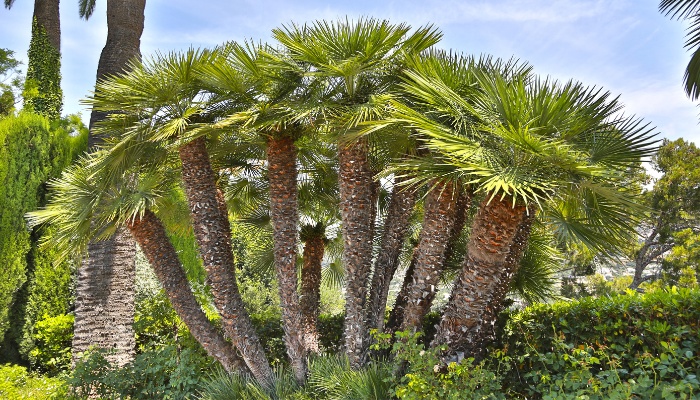
Originally from the Mediterranean, this tree with its fan-shaped fronds and yellow flowers took well to California weather and soil.
- Where they grow: All over California
- Average size: 6 to 15 feet tall and 15 feet wide
- Growth rate: 10 inches per year
- Distinguishing characteristics: Several trunks, fan-shaped leaves, and yellow flowers
12. Triangle Palm (Dypsis decaryi)

Unlike other palms in California, this one has a flat canopy that grows out of a short trunk. It’s ideal for small spaces.
- Where they grow: California and Madagascan rainforest
- Average size: 5-30 feet tall and 12-15 feet wide
- Growth rate: 7 inches per year
- Distinguishing characteristics: Flat fan-shaped fronds, short and slender trunk
13. Bismarck Palm (Bismarckia nobilis)
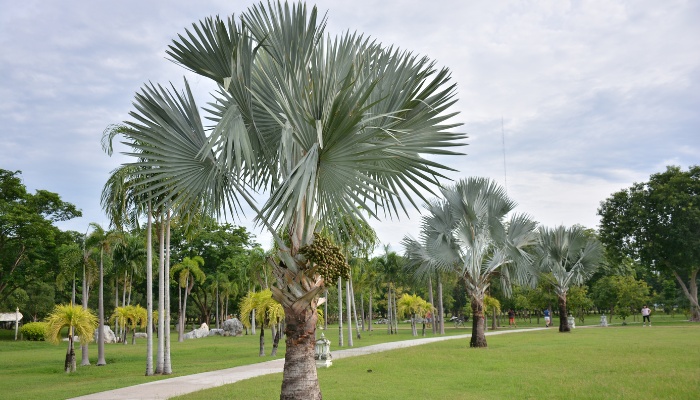
The thick trunk and gray-silver leaves give this palm its distinctive appearance. It has a slow growth rate and takes years to reach maturity.
- Where they grow: Southern California
- Average size: 40 to 70 feet tall and 10 to 15 feet wide
- Growth rate: 1 foot yearly
- Distinguishing characteristics: Thick trunk and fan-shaped silver leaves
14. Pindo Palm (Butia capitata)

Originally from Brazil, this palm cuts a fine figure in the public parks of southern California. It is also commonly referred to as jelly palm.
- Where they grow: Warm parts of California and Brazil
- Average size: 15-20 feet tall, and 15 feet wide
- Growth rate: 12 inches
- Distinguishing characteristics: Robust and upright trunk with arching green fronds
15. Sago Palm (Cycas revoluta)
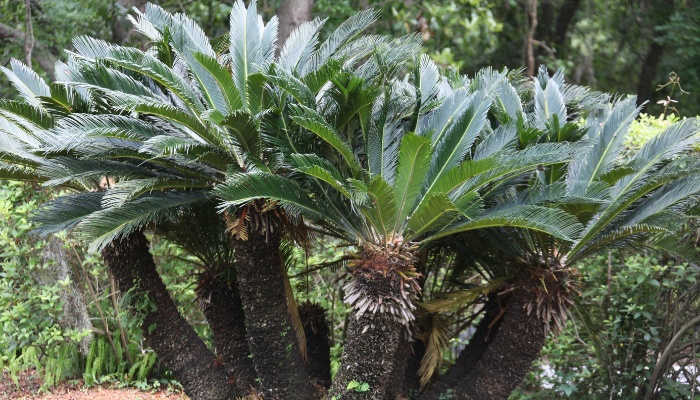
You can easily grow this Japanese palm in a pot and keep its size compact. The small trunk is quite ornamental as well as the green fronds.
- Where they grow: Native to Japan but common in southeastern California
- Average size: 3 to 8 feet, 2 to 12 feet
- Growth rate: 6 inches yearly
- Distinguishing characteristics: Short and thick trunk with fan-like green fronds
16. Parlor Palm (Chamaedorea elegans)

Without a trunk, this palm doesn’t take up a lot of space. The fronds grow out of the ground and arch in all directions.
- Where they grow: Southern California, Mexico, and Guatemala
- Average size: 6-16 feet tall and 2-3 feet wide
- Growth rate: 6 inches per year
- Distinguishing characteristics: No trunk, long green fronds come out of the crown
17. Christmas Palm (Adonidia merrillii)

Native to the Philippines, Californians fell in love with this palm with its shapely leaves and massive clusters of red fruits.
- Where they grow: California and Philippines
- Average size: 20 to 25 feet tall, 15 feet wide
- Growth rate: 2 feet yearly
- Distinguishing characteristics: Arching pinnate leaves, red clusters of fruits
18. Spindle Palm (Hyophorbe verschaffeltii)

The medium-size trunk is smooth and slender, and the green fronds are very decorative.
- Where they grow: California and Mauritius
- Average size: 18 feet tall, 10 feet wide
- Growth rate: 1 foot each year
- Distinguishing characteristics: Slender and smooth trunk that tapers toward the end and green fronds
19. Cuban Royal Palm (Roystonea regia)

Once the most common palm tree in royal palaces, this palm now dots the streets of Havana, Florida, Mexico, and California.
- Where they grow: California, Florida, Cuba, Mexico
- Average size: 50 to over 80 feet tall, 20 feet wide
- Growth rate: 2 feet per year
- Distinguishing characteristics: Ornate slender trunk with a green top, slim fronds
20. San Jose Hesper Palm (Brahea brandegeei)
Although it lacks the sleek elegance of other palms, there’s a certain beauty to the rough edges of this palm.
- Where they grow: Baja California
- Average size: 40 to 60 feet and 15 feet wide
- Growth rate: 1 foot per year
- Distinguishing characteristics: Rough trunk with fan-shaped fronds
21. Saw Palmetto (Serenoa repens)

This is another palm that you can grow as a houseplant. It has grouped fronds with stunning beauty.
- Where they grow: South California, Florida, South Carolina
- Average size: 7-10 feet tall
- Growth rate: 5 inches each year
- Distinguishing characteristics: Short and slender trunk with clusters of fronds growing out of its top
22. Dwarf Palmetto (Sabal minor)
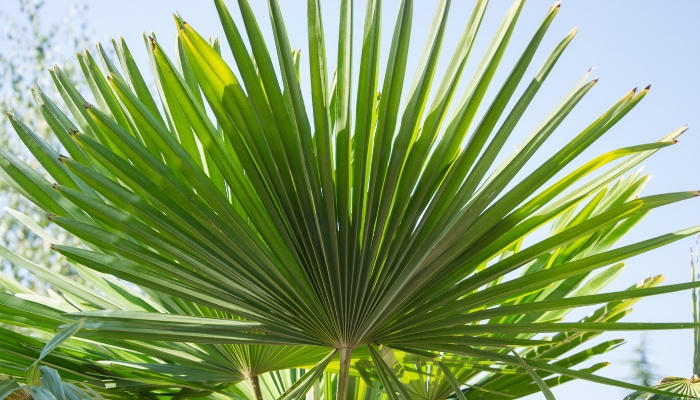
This is a popular palm to grow indoors as the bushy fronds don’t take up much space.
- Where they grow: California and Mexico
- Average size: 2 to10 feet tall
- Growth rate: 6 inches per year
- Distinguishing characteristics: Short trunk and green and bushy fronds
23. Dwarf Majesty Palm (Ravenea hildebrandtii)
The trunk tapers at the top and gains girth as it nears the ground.
- Where they grow: The Comoros
- Average size: 7 feet tall, 12 feet wide
- Growth rate: 7 inches yearly
- Distinguishing characteristics: Bloated trunk that tapers at the top, fan-like dark-green fronds
24. Dwarf Sugar Palm (Arenga engleri)

This is another trunkless palm with feather-like leaves coming out of the ground.
- Where they grow: Southwestern California
- Average size: 8 feet tall and up to 16 feet wide
- Growth rate: 6 inches per year
- Distinguishing characteristics: No trunk, feather-like leaves, orange flowers
25. Mule Palm (X Butiagrus nabonnandii)
This hybrid palm is sterile, hence the name. It has a slender trunk and fan-like fronds.
- Where they grow: Southern California
- Average size: 15 to 30 feet tall, 6 to 8 feet in width
- Growth rate: 7 inches each year
- Distinguishing characteristics: Slender and upright trunk with fan-like thick fronds
Closing Thoughts
Famous for its wide range of palm tree species, California has only one native palm tree. The rest were imported where they adapted well to the weather and soil.
Palm trees dot the streets, public parks, gardens, and landscapes of the whole of California and give its beaches their distinguishing qualities.


 (@thepalmenthusiast)
(@thepalmenthusiast)